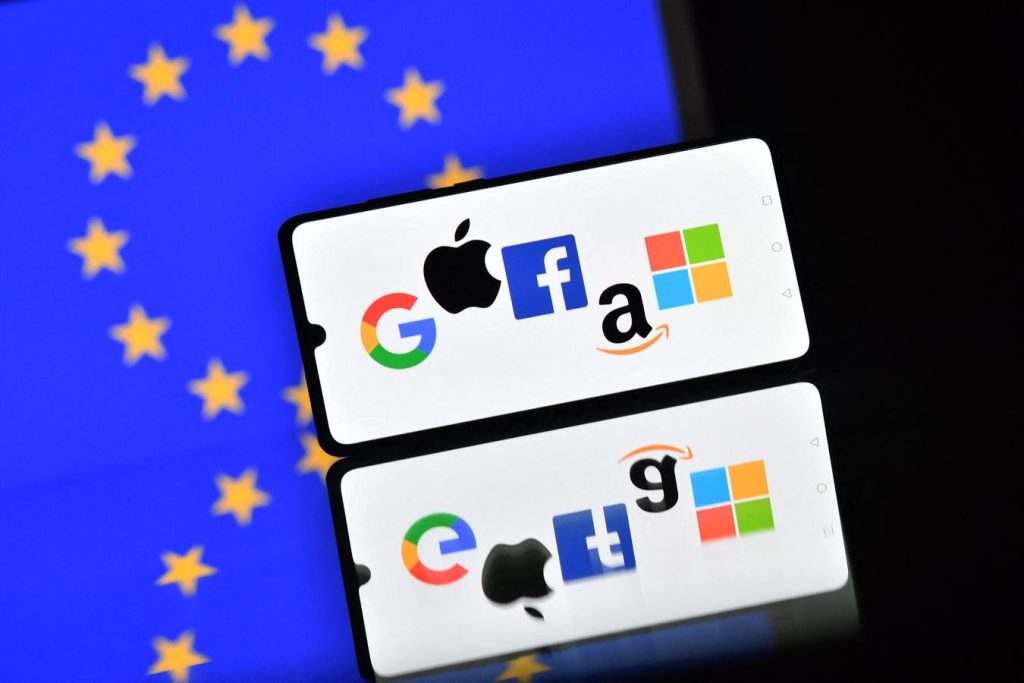Recent Q1 earnings releases from Microsoft, Amazon, Alphabet and Meta reaffirmed that AI spending is continuing to increase through 2024 as companies seek AI-related revenue gains.
The tech giants are continuing to dedicate tens of billions each towards AI infrastructure, and overall were broadly optimistic over the opportunities that generative AI brings to growth and the value that these AI services provide to end customers. Below, we take a look at Big Tech’s Q1 earnings, AI commentary and capex plans for 2024, and what this means for the broader AI industry.
Q1 Earnings: AI Aids Revenue Gains
Big Tech’s reported revenue growth rates in Q1 were higher than anticipated just over two quarters ago. Meta is seeing one of the largest accelerations at 10 percentage points due to accelerating advertising revenue as ad prices recover. Microsoft is reporting one of the largest AI contributions of 7 points within Azure, which helped raise estimates by 550 bps. Across the board, however, Big Tech is accelerating which is not merely a coincidence.
Microsoft beat on the top and bottom line with $61.85 billion in revenue, representing a second straight quarter with revenue growth above 17% YoY. This is the first time it’s been above 17% in two years. This was driven by 21% growth in Intelligent Cloud, and in that, an acceleration to 31% growth in Azure, with 7 percentage points from AI.
Recall that in our Big Tech Stocks: Q3 Earnings Preview from October, prior to Microsoft’s September quarter report (which saw AI’s first contributions to Azure’s growth), Microsoft was expected to see 10% to 11.5% revenue growth these past two quarters – at this revenue scale, up to a 6 percentage point acceleration in three quarters marks an inflection point. For a more in-depth look at Microsoft’s recent earnings report, read the analysis: “Microsoft Fiscal Q3: 80% YoY Increase in Capex; Azure AI is Hitting Capacity”
Alphabet easily beat Q1 revenue and EPS estimates as both Google Cloud (GCP) and Search revenue growth accelerated, combined with strong YouTube revenue growth. Overall revenue growth was 15.4% in Q1, the fastest in two years, and a strong acceleration from just 2.6% growth in the year ago quarter. Similar to Microsoft, increasing contributions from AI in GCP and resilient Search and YouTube ad revenues has resulted in revenue growth that is nearly 4 percentage points higher than Q1’s 11.8% growth estimate from October.
Meta reported 27.3% revenue growth and a solid EPS beat in Q1, as it captured tailwinds from 20% growth in ad impressions combined with 6% growth in ad prices. The ad impressions have cooled from 30% growth in mid 2023. Revenue gains were strongest in Rest of World and Europe at nearly 42% and 34% YoY, as Meta capitalized on double-digit growth in ad prices in those regions. While AI is aiding with improved ROI and automation for advertisers, Meta struck a nerve as it downplayed near-term revenue recognition from increased AI investments and the stock sold off nearly 11% after the earnings report.
Amazon rounded out the double beats from Big Tech as it notched a top and bottom line beat due to a 4-percentage point acceleration in AWS sales to 17% YoY and strong 24% growth in advertising revenue. AWS surpassed a $100 billion annualized run rate in the first quarter, with management noting that they “see more absolute dollar growth again quarter-over-quarter in AWS than we can see elsewhere.”
We’re also seeing the four Big Tech companies report significant YoY improvements in operating margin, with Meta recording the largest expansion at 13 percentage points. Amazon’s operating margin improved 7 percentage points from an increase in AWS’ operating margin to 38%, which was up 14 percentage points. Cost management efforts combined with improvements in operating leverage, aided by AI growth and efficiency gains, can help the four Big Tech companies maintain and drive full-year operating margin expansion.
Management Positive About AI’s Potential
Management teams from The Four offered positive commentary about AI’s potential to drive new growth. On the earnings call, it was discussed that AI can help to improve ROI for advertisers, help drive more infrastructure revenue (already seen in beats from Azure, GCP, and AWS), plus AI will help to innovate across customer-facing applications.
Let’s dig in to some of the top quotes and stats shared from each management team.
Microsoft:
Microsoft shared some of the more impressive (and arguably most important) stats around AI, with CEO Satya Nadella providing multiple strong growth rates for AI products and insights into AI demand.
He noted that Azure Arc now has “33,000 customers, up over 2X year-over-year,” while the “number of 100 million dollar-plus Azure deals increased over 80% year-over-year, while the number of 10 million dollar-plus deals more than doubled.”
GitHub Copilot now has “1.8 million paid subscribers, with growth accelerating to over 35% quarter-over-quarter” and revenue growth of 45% YoY. In terms of device penetration, “Copilot in Windows is now available on nearly 225 million Windows 10 and Windows 11 PCs, up 2X quarter-over-quarter.”
However, one of the most important pieces was that Microsoft’s current “near-term AI demand is a bit higher than our available capacity,” meaning its available GPU supply is not enough to meet demand from customers. Read more here.
Meta:
After launching its newest AI assistant powered by its Llama 3 model in mid-April, Meta CEO Mark Zuckerberg said the “initial rollout of Meta AI is going well. Tens of millions of people have already tried it.” He later added that he believes “Meta AI with Llama 3 is now the most intelligent AI assistant that you can freely use.”
Zuckerberg also noted that “about 30% of the posts on Facebook feed are delivered by our AI recommendation system. That’s up 2x over the last couple of years. And for the first time ever, more than 50% of the content people see on Instagram is now AI recommended.”
In terms of how AI is aiding revenue, CFO Susan Li explained that “with our core AI work, we continue to have a very ROI-driven approach to investment, and we’re still seeing strong returns as improvements to both engagement and ad performance have translated into revenue gains.”
Alphabet:
Alphabet CEO Sundar Pichai said that Google has “already served billions of queries with our generative AI features” while also “seeing an increase in Search usage among people who use the new AI overviews, as well as increased user satisfaction with the results.”
In addition, he added that “more than 60% of funded gen AI startups and nearly 90% of gen AI unicorns are Google Cloud customers,” and “more than one million developers are now using our generative AI across tools including AI Studio and Vertex AI.” We are covering Google this week in detail for our premium members.
Amazon:
Amazon also shared some impressive stats about AI tool adoption as well as its revenue contribution, with CEO Andy Jassy saying that Amazon sees “considerable momentum on the AI front, where we’ve accumulated a multi-billion dollar revenue run rate already.” Microsoft is similarly in the multi-billion dollar range in Azure, where the 7% boost to growth is correlating to an approximate $4 billion run rate.
CFO Brian Olsavsky added that AWS has surpassed a $100 billion run rate and that’s “before you even calculate gen AI, most of which will be created over the next 10 to 20 years from scratch and on the cloud.”
Amazon’s managed end-to-end service SageMaker is aiding in LLM training, AI inference, and productivity improvements, with management stating that “Perplexity AI trains models 40% faster in SageMaker [and] Workday reduces inference latency by 80% with SageMaker.”
We recently entered an AI hardware stock to capitalize on Big Tech’s surging capex and GPU purchases, and may soon make it our highest allocation in our portfolio, with premium members receiving real-time trade alerts on this stock and the rest of our portfolio. Learn more about our premium memberships here.
Capex Surging More Than 35% YoY In 2024
Big Tech will likely commit upwards of $200 billion, maybe even $210 billion, combined in capex this year, predominantly for AI infrastructure – from data center construction and expansion, to GPU procurement and custom silicon efforts and more.
It’s no wonder the four are boosting capex by more than 35% YoY, given positive outlooks on AI’s potential to drive revenue growth in the billions and how demand continues to outstrip GPU supply. Overall, capex commentary from the four was directionally bullish for AI semiconductors and server manufacturers, though Meta’s vagueness on a timeline to recognize a return on said spend hit shares quite hard.
Microsoft:
Microsoft increased its capex 80% YoY to $14 billion this quarter, and for the entire fiscal year, capex will increase approximately 50% YoY to more than $50 billion. Demand for Azure’s AI services is outpacing its capacity in the near-term, hence the need for Microsoft to accelerate spending to boost GPU supply. It has been reported that Microsoft is seeking to triple its GPU supply this year to 1.8 million GPUs.
Alphabet:
Alphabet’s capex rose 91% YoY to $12 billion in Q1, primarily for technical infrastructure – this capex spend was led by servers and followed by data centers. Management is expecting quarterly capex “to be roughly at or above the Q1 level,” implying a full-year capex around $50 billion, an increase of ~55% YoY. Management said this significant growth in capex “reflects our confidence in the opportunities offered by AI across our business.”
CFO Ruth Porat explained that “as we’re investing in CapEx and applying it across our various businesses, it opens up more service and products, which bring revenue opportunities, and we’re very focused on the monetization opportunity,” which spans Search, Cloud, YouTube, and other services. CEO Sundar Pichai emphasized that Alphabet has “clear paths to AI monetization through Ads and Cloud, as well as subscriptions.”
Meta:
Meta boosted its full year capex range to $35-40 billion, pointing to 33% YoY growth and $4 billion more than previously anticipated, to build out AI infrastructure and support its internal AI roadmap. Meta’s Q1 capex was only $6.7 billion, implying that the bulk of this spend will hit in the second half of the year, possibly accelerating at a ~20% QoQ rate and exiting 2024 above the $11 billion range. However, despite these aggressive investments in AI, Meta was rather vague on its returns, saying it is very early on the return curve:
As we’re scaling capex and energy expenses for AI, we’ll continue focusing on operating the rest of our company efficiently. But realistically, even with shifting many of our existing resources to focus on AI, we’ll still grow our investment envelope meaningfully before we make much revenue from some of these new products.
Once our new AI services reach scale, we have a strong track record of monetizing them effectively. There are several ways to build a massive business here, including scaling business messaging, introducing ads or paid content into AI interactions, and enabling people to pay to use bigger AI models and access more compute.”
Despite the hints of positivity in creating and monetizing new services, the commentary highlights a rather important angle that the market does not like – an unclear timeline to when a return on increased investments will be recognized. This is quite the polar opposite from Microsoft and Amazon, who have multi-billion dollar AI revenue streams that will immediately benefit from increased expenditures on capacity expansion. The difference is that AWS and Azure are more enterprise or startup related whereas Meta is more consumer related. It’s been our contention that AI is an enterprise technology first and foremost when we held a webinar in 2022 when it was stated about AI that: “enterprises are going to drive forward the gains over the next 10 years, it will not be consumer.”
Amazon:
Amazon did not provide a full-year figure for capex, but management said they anticipate capex will “meaningfully increase year-over-year in 2024, primarily driven by higher infrastructure CapEx to support growth in AWS, including generative AI.” In addition, they expected the $14 billion capex sum for Q1 will “be the low quarter for the year,” suggesting capex could easily top $60 billion, exiting the year in the mid-$60 billion range or higher, an increase of at least 24% YoY.
CEO Andy Jassy explained this capex growth is driven by “the combination of AWS’ reaccelerating growth and high demand for gen AI, … which given the way the AWS business model works is a positive sign of the future growth. The more demand AWS has, the more we have to procure new data centers, power and hardware.”
Implications For the Broader AI Industry
This increased spending by Big Tech ultimately is flowing to multiple core components for infrastructure expansion and increased GPU capacity. Management teams are talking about more GPU purchases, more custom silicon buildout, data center expansion, and the need for more hardware (networking and switches). For example, since the start of this year, consensus revenue estimates for Nvidia have already risen from $91 billion at the beginning of January to $112 billion at the beginning of May – an increase of $21 billion. This goes hand in hand with its new GPU releases and increased Big Tech spending.
However, AI opportunities extend well past Nvidia. We’ve been closely monitoring Big Tech for years while identifying the top beneficiaries from this blistering AI-driven increase in capex. We routinely share our research with our premium members including how this impacts AI semiconductors such as GPUs and custom silicon, memory players, and AI networking.
If you own AI stocks, or are looking to own AI stocks, we encourage you to attend our weekly premium webinars, held every Thursday at 4:30 pm EST. Next week, we will discuss a handful of AI plays for 2024 – what our targets are, where we plan to buy as well as take gains. Learn more about I/O Fund’s premium services here.
I/O Fund Equity Analyst Damien Robbins contributed to this report.
Read the full article here










